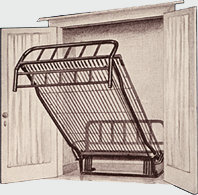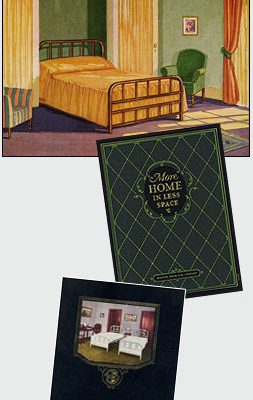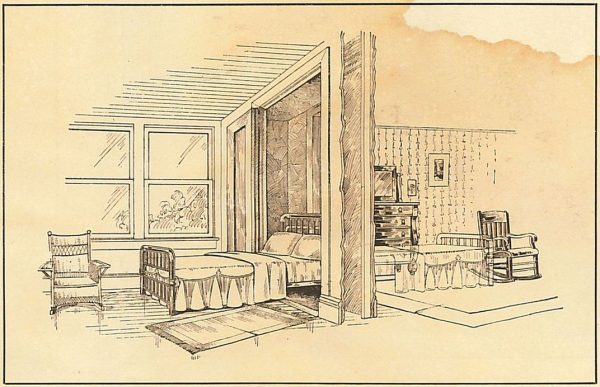William Murphy was not the first pioneer of space-saving furniture, but thanks to some clever innovation, good timing and fortuitous funding, his surname has become the household name in foldout beds and a widely used generic applied to similar designs.
Murphy was born in 1876 to a miner in a Gold Rush-era boomtown near Stockton, California. Growing up, he bounced around between places and jobs before landing in the middle of San Francisco. There, in 1900, he designed the bed for which he would become famous.
 In the big city, he faced the same problem many still do today: insufficient space. To make room in his studio apartment, he designed a bed with a pivot system allowing it to fold neatly up into a wardrobe. According to family lore, he was particularly motivated to innovate for very personal reasons.
In the big city, he faced the same problem many still do today: insufficient space. To make room in his studio apartment, he designed a bed with a pivot system allowing it to fold neatly up into a wardrobe. According to family lore, he was particularly motivated to innovate for very personal reasons.
For context: given the social mores of that era, it would have made it ungentlemanly for him to court a partner in an all-in-one space that (among other things) served as his bedroom.
 As the story goes, Murphy made his first bed in 1900 specifically to court an opera singer in whom he was romantically interested. Able to stow his bed on demand, he could invite her over to his place without violating norms of the era and risking scandal. He then went on to marry that same woman, and with funding from her father began a company to make more such beds.
As the story goes, Murphy made his first bed in 1900 specifically to court an opera singer in whom he was romantically interested. Able to stow his bed on demand, he could invite her over to his place without violating norms of the era and risking scandal. He then went on to marry that same woman, and with funding from her father began a company to make more such beds.
Murphy’s bed “In-A-Door” went from being a pragmatic solution developed mostly for working-class people like himself to a status symbol for richer urban dwellers with big-city condos in places like New York City. As more and more people moved into increasingly crowded urban areas, the design grew popular across the wealth spectrum, appealing to everyone seeking to save a bit of space, which, in a city, is just about everyone.
In many ways, the rise and fall (and rise again) of Murphy beds have followed the trajectory of urban development. Murphy beds took off as workers pivoted from rural agriculture to city industries. The beds lost ground in the wake of World War II as veterans and others pushed out into larger suburban homes, but gained traction again during periodic recessions and later as more people began moving back into cities.
While its popularity in private homes has gone up and down, this bed design strategy has also made its way out of residences and into other contexts, like dormitories and hospitals, hotels and cruise ships. Other variants on the concept have emerged as well, including futons but also couches that transform into bunk beds and even beds that pull down from ceilings, which can offer different benefits in various spaces.
It is hard to say how much this evolution traces back to Murphy’s innovation, but the range of space-saving, multi-functional and transforming furniture designs has grown significantly over the past century. There are of course classic folding card tables, but all kinds of other creative designs too for converting one kind of space into another on-demand, from studio apartments to wedding venues, including ones that still span the wealth spectrum, like folding chairs.




Comments (3)
Share
Great article! The standard murphy bed has evolved into a truly multi-functional piece of furniture, by having a dual-purpose such as a sofa and bed or a desk and a bed, and other ways you mentioned in the article. More and more, Hospitality designers, architecture firms, and property owners are discovering these modern murphy beds as a way to maximize the limited space and provide flexibility. Once durability and styling is addressed, it really makes sense to incorporate into the overall design.
I may be alone in my assertion, but as an interior designer with emphasis on functional design, I detest Murphy beds.
Think about it: if you have the floor space available when a Murphy bed is stowed away, you cannot typically use that space because you need it to accommodate the bed when it’s released. You could possibly have a light table and chairs that can be pushed to the sides of the room at bedtime, or you could use it for yoga or other non-equipment exercise during the day, but that’s about it.
For this reason, Murphy beds in no way “save space.” If a Murphy bed is used in a guest room, the same logic applies and you might as well use a regular bed or a sofa bed (a much more useful invention!).
As I learned in the article above, the original use was to hide the bed for reasons of propriety and makes perfect sense!! But space-saving, Murphy beds are NOT!
Awesome! I pitched this idea to you all close to 5 years ago, after I moved into an old studio apartment that featured a Murphy bed. I still live here, because having a multifunctional space that allows me to minimize the possessions I buy, but still maintain privacy when I have visitors has been so great. I will forever shout praises about this awesome invention!